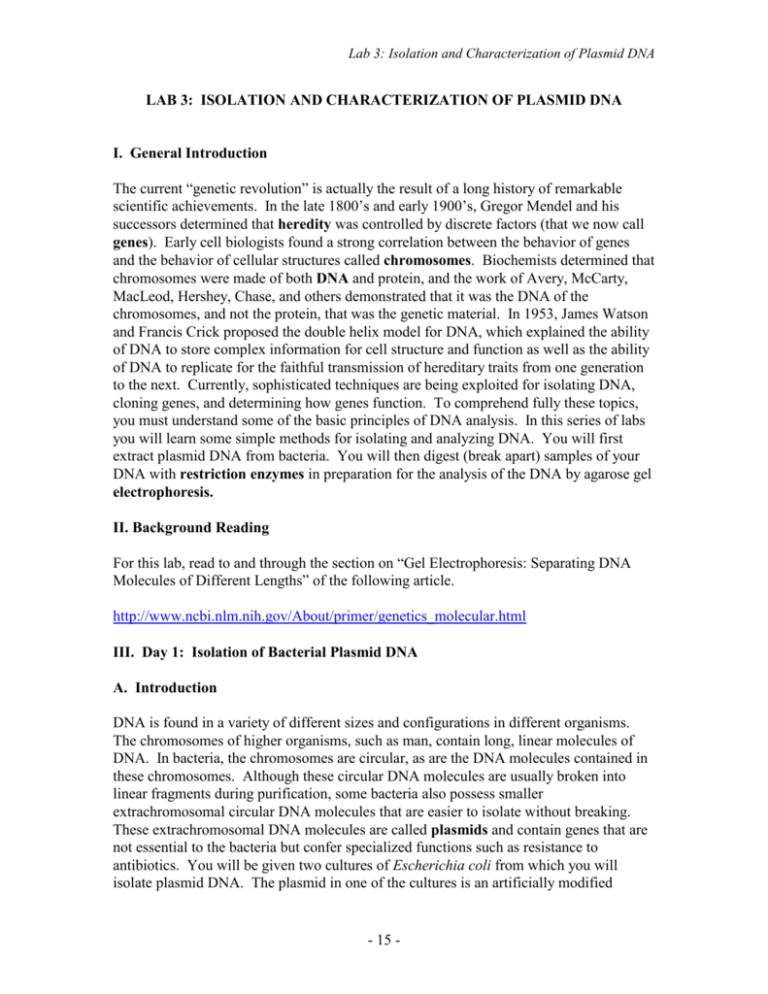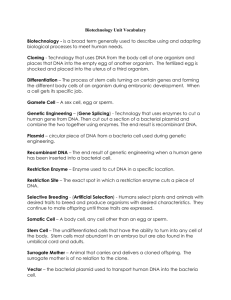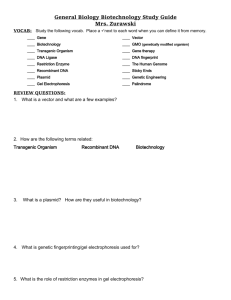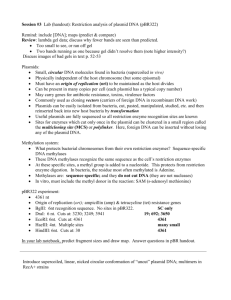Lab 7: Molecular Biology
advertisement

Lab 3: Isolation and Characterization of Plasmid DNA LAB 3: ISOLATION AND CHARACTERIZATION OF PLASMID DNA I. General Introduction The current “genetic revolution” is actually the result of a long history of remarkable scientific achievements. In the late 1800’s and early 1900’s, Gregor Mendel and his successors determined that heredity was controlled by discrete factors (that we now call genes). Early cell biologists found a strong correlation between the behavior of genes and the behavior of cellular structures called chromosomes. Biochemists determined that chromosomes were made of both DNA and protein, and the work of Avery, McCarty, MacLeod, Hershey, Chase, and others demonstrated that it was the DNA of the chromosomes, and not the protein, that was the genetic material. In 1953, James Watson and Francis Crick proposed the double helix model for DNA, which explained the ability of DNA to store complex information for cell structure and function as well as the ability of DNA to replicate for the faithful transmission of hereditary traits from one generation to the next. Currently, sophisticated techniques are being exploited for isolating DNA, cloning genes, and determining how genes function. To comprehend fully these topics, you must understand some of the basic principles of DNA analysis. In this series of labs you will learn some simple methods for isolating and analyzing DNA. You will first extract plasmid DNA from bacteria. You will then digest (break apart) samples of your DNA with restriction enzymes in preparation for the analysis of the DNA by agarose gel electrophoresis. II. Background Reading For this lab, read to and through the section on “Gel Electrophoresis: Separating DNA Molecules of Different Lengths” of the following article. http://www.ncbi.nlm.nih.gov/About/primer/genetics_molecular.html III. Day 1: Isolation of Bacterial Plasmid DNA A. Introduction DNA is found in a variety of different sizes and configurations in different organisms. The chromosomes of higher organisms, such as man, contain long, linear molecules of DNA. In bacteria, the chromosomes are circular, as are the DNA molecules contained in these chromosomes. Although these circular DNA molecules are usually broken into linear fragments during purification, some bacteria also possess smaller extrachromosomal circular DNA molecules that are easier to isolate without breaking. These extrachromosomal DNA molecules are called plasmids and contain genes that are not essential to the bacteria but confer specialized functions such as resistance to antibiotics. You will be given two cultures of Escherichia coli from which you will isolate plasmid DNA. The plasmid in one of the cultures is an artificially modified - 15 - Lab 3: Isolation and Characterization of Plasmid DNA plasmid that has been engineered for use as a cloning vector. The term vector refers to its ability to take a piece of foreign DNA into a bacterial cell and allow that foreign DNA to be replicated -- the replication of foreign DNA in bacteria is, in essence, gene cloning. The plasmid in the other culture is a derivative of the same cloning vector that has actually been spliced (joined) to a piece of DNA originally isolated from rabbits. Plasmids that consist of DNA from two different biological sources (i.e., bacteria and rabbits) are called recombinant plasmids. Later you will learn how this recombinant plasmid was generated and will verify the presence of the rabbit DNA segment, but first you must isolate these two types of plasmid DNA. By centrifugation, you will concentrate the bacterial cells into a dense pellet at the bottom of a centrifuge tube. The cells will be suspended in a lysis buffer that contains lysozyme, an enzyme that degrades bacterial cell walls. Boiling the cells in this buffer for a short time breaks open the cells and releases the small circular plasmids. The larger bacterial chromosome is attached to the inside of the bacterial membrane in the living cell, and after cell lysis, remains attached to pieces of the membrane that form pellets when centrifuged. The plasmid DNA is then precipitated from the supernatants with isopropyl alcohol. B. Materials overnight culture of bacteria containing the cloning vector overnight culture of bacteria containing the recombinant plasmid STET buffer (Sucrose, Triton-X, EDTA, and Tris) lysozyme solution (10 mg/ml in H2O, made fresh) TE (Tris, EDTA) isopropyl alcohol 70% ethanol microcentrifuge vortex mixer hot plate, dish, and microtube float (for boiling water bath) 4oC refrigerator and -20oC freezer Pipetman and tips 1.5 ml microfuge tubes waste beakers ice buckets with ice toothpicks Bunsen burner and dissecting needle C. Procedure (work in groups of two) 1. Label three 1.5 ml microfuge tubes vector, and three r-plasmid. Include your initials here and any time you are labeling tubes. 2. Transfer 1.4 ml of the bacterial culture containing the cloning vector into each of two of the vector tubes and 1.4 ml of the bacterial culture containing the recombinant plasmid into each of two of the r-plasmid tubes. This is most conveniently done by - 16 - Lab 3: Isolation and Characterization of Plasmid DNA transferring 0.7 ml twice to each tube. Make sure you swirl the cultures just before taking your samples to disperse the bacteria that have settled to the bottom of the flasks. 3. Place the microfuge tubes in the microcentrifuge such that the tube hinges point away from the center of the rotor. Do not forget to balance the rotor. Spin tubes for 5 minutes at the maximal speed. Pour the supernatants into waste beaker and then remove as much of remaining fluid as possible with a P200 Pipetman set to ~80 l. DO NOT TOUCH THE PELLET WITH THE PIPET TIP! 4. Add 70 l of STET buffer to each pellet. Vortex until the pellets are suspended. Add 5 l lysozyme solution to each tube and vortex to mix. When adding the lysozyme, use the pipette tip to disrupt any bacterial pellet that did not suspend while vortexing. 5. Pierce the tops of the microfuge tubes with a flamed needle as will be demonstrated by your TAs, and then float the tubes in a boiling water bath for exactly 40 seconds. After boiling, spin the tubes for 1 minute in the microcentrifuge at maximum speed. 6. Add 70 l TE to each tube. Spin tubes for another 10 minutes at maximum speed. At the bottom of each tube should now be a large, flocculent pellet under a small volume of fluid (the supernatant). Spear the flocculent pellet in each tube with a toothpick, slowly drag the pellets out of the tubes (allowing residual fluid to drain back to the bottom of the tube), and discard the pellets in an appropriate waste container. 7. Set the P-200 Pipetman to 25 l and transfer the supernatants from the two vector tubes into a single, clean microfuge tube. Keep track of the total volume transferred (by counting how many 25 l aliquots are transferred), and record that volume here: vector volume________. In the same manner, combine the supernatants for the two r-plasmid preparations into a single tube: r-plasmid volume_______. 8. To each tube, add a volume of isopropyl alcohol that is equal to the supernatant volume recorded for that tube in the previous step. Vortex and incubate at -20oC for 20 minutes or longer. 9. Spin tubes for 5 minutes in microcentrifuge (maximum speed setting), once again pointing the tube hinges away from the center of the rotor. Pour off supernatants into a waste beaker. Gently add 400 l of 70% ethanol to each pellet. Spin for 5 minutes at maximum speed. Pour off supernatants, pop spin, and then remove as much of the remaining fluid as possible with a Pipetman and without disturbing the pellet. Invert tubes to dry on a Kimwipe for a minimum of 20 minutes. 10. Add 40 l of TE to each pellet (your instructor or TAs may suggest a different volume after inspecting your pellets - check with them before adding the TE). Let tubes sit at room temperature for 5 minutes and then vortex briefly. Store tubes at 4oC. - 17 - Lab 3: Isolation and Characterization of Plasmid DNA IV. Day 2: Restriction Enzyme Digestion of DNA Samples A. Introduction The manipulation and analysis of DNA has been greatly facilitated by a remarkable group of enzymes called restriction enzymes. These enzymes are found in bacteria and protect the bacteria from viral infection by cutting viral DNA into harmless pieces. The mechanism of cutting is such that the enzyme recognizes and cuts the DNA at a specific sequence of nucleotide base pairs. Each bacterial species that has been investigated has a different restriction enzyme that recognizes and cuts a different sequence of base pairs. Purified restriction enzymes are used by molecular biologists to cut large DNA molecules into smaller and more manageable pieces. An important property of restriction enzymes is that the ends of DNA fragments generated by restriction enzyme digestion have singlestranded extensions that are complementary to the extensions on any DNA fragments generated by the same restriction enzyme (see diagram below). Because of this property, fragments of DNA from different biological sources can be spliced (joined) together if they were generated by digestion with the same restriction enzyme. This is the basis of gene cloning which involves the splicing of a specific fragment of DNA into a restriction enzyme site in a cloning vector such as a bacterial plasmid. Upon reintroduction of the recombinant plasmid into a bacterial cell, the bacterium serves as a factory for the generation of large quantities of the cloned DNA for a variety of biochemical investigations. This week you perform restriction enzyme digestions of your plasmid DNA preparations. Upon subsequent analysis of the DNA by gel electrophoresis, you will get a visual demonstration of the changes in the configuration of DNA that accompany restriction enzyme digestion and will see how it is possible to map restriction enzyme sites in cloned DNA. The digestions with restriction enzymes are simple to perform. Each reaction will consist of a small sample of one of your DNA preparations, a purified restriction enzyme purchased from a biological supply firm, a buffer mixture that provides the salts and pH to optimize the activity of the restriction enzyme, and ddH2O to bring the volume of each reaction to 20 µl. The volume of the reaction is important because the buffer was designed to be diluted exactly 10 fold to provide the optimal enzyme conditions. The restriction enzymes we will use are PstI (isolated from the bacterium Providencia stuartii) and EcoRI (isolated from Escherichia coli strain RY 13). The base pair sequence that these enzymes recognize, and the reactions catalyzed by each enzyme are illustrated below. 5'----------CTGCAG----------3' 3'----------GACGTC----------5' + PstI 5'----------GAATTC----------3' 3'----------CTTAAG----------5' + EcoRI 5'----------G AATTC------------3' 3'----------CTTAA G------------5' - 18 - 5'----------C TGCAG------------3' 3'----------GACGT C------------5' Lab 3: Isolation and Characterization of Plasmid DNA B. Materials BRL REact buffer 2 BRL REact buffer 3 PstI enzyme (10 units/l) EcoRI enzyme (10 units/l) 10x gel juice ddH2O Pipetman and tips tabletop centrifuge microfuge tubes 37oC water bath and microfuge tube floats ice buckets and ice C. Procedure 1. Label six 1.5 ml microfuge tubes 1-6, and include your initials. 2. Set up restriction enzyme digests of your DNA samples by adding the ingredients in Table 1 to the tubes in the order shown (i.e., first add DNA to all tubes, then add water, then buffer, and then enzyme). Make sure that you spin your plasmid DNA tubes and the reaction buffer tubes for a few seconds in the microcentrifuge before taking samples from them. Also, put restriction enzyme stocks back in the ice bucket as soon as you are done with them. 3. Briefly vortex your reaction tubes, pop spin, and float them in the 37oC water bath for 60 min. 4. After the 60 min. incubation, add 2 l of 10x gel juice to each tube, vortex and pop spin. Store tubes at 4oC in the refrigerator. Table 1: Ingredients for restriction enzyme digestion of DNA samples sample 1 r-plasmid DNA 4 µl 2 r-plasmid DNA 4 µl 3 r-plasmid DNA 4 µl 4 r-plasmid DNA 4 µl 5 vector DNA 4 µl 6 vector DNA 4 µl ddH2O 16 µl 13 µl 13 µl 12 µl 16 µl 13 µl buffer none 2 µl REact buffer 3 2 µl REact buffer 2 none 2 µl REact buffer 3 enzyme none 1 l EcoRI 1 µl PstI 2 µl REact buffer 2 1 µl PstI and 1 µl EcoRI DNA - 19 - none 1 µl EcoRI Lab 3: Isolation and Characterization of Plasmid DNA V. Day 3: Electrophoresis of Restriction Enzyme Digests and Uncut DNA Samples A. Introduction Today you will examine the restriction enzyme digestions you performed last session. Electrophoresis is one of the most common techniques used by cellular and molecular biologists. The basis of electrophoresis is that nucleic acids (DNA or RNA), or proteins coated with the negatively charged detergent sodium dodecyl sulfate, have uniform negative charges and migrate towards the positive pole in an electric field. If macromolecules are forced to migrate through a semisolid matrix (gel) formed by polymers such as agarose or acrylamide, they will worm their way through the microscopic pores within the polymer matrix, and small molecules will pass through the pores with greater ease and speed than larger molecules. This means that if a mixture of DNA molecules is electrophoresed for a fixed period of time, the molecules will separate according to size, with the smaller fragments migrating to a greater distance than the larger molecules. Because the distance of migration is inversely proportional to size, the actual sizes of the DNA fragments can be determined by comparing the distances they migrated to the migration of DNA fragments with known sizes (size standards). You will see that the configuration of the DNA can also affect its ability to migrate through an electrophoretic gel. The plasmid DNAs you isolated earlier are primarily in the form of super-coiled circles in which the circular double helices are coiled up like an over wound yo-yo string (this super-coiling is actually in response to an under winding of the two strands of the double helix). The tightly compacted structure of the super-coiled circles allows them to migrate faster during electrophoresis than linear DNA with the same base pair composition. However, if one of the strands is broken, the other strand maintains the circular nature of the plasmid, but the coiling is reduced and the result is a relaxed circle. The bloated structure of the relaxed circle inhibits its migration through the agarose pores, and the relaxed circle migrates more slowly than a linear molecule of the same base pair composition. If both strands of the DNA molecule are broken the molecule is linearized (linear plasmid) and migrates at a speed that is intermediate between those of the super-coiled and relaxed circular forms. In addition to super-coiled, relaxed circles, and linear plasmids, even more slowly migrating forms are often found. These are called concatemers and occur when several circular plasmids are linked together like the links of a bracelet. With some help, you will be able to identify each of these forms in your undigested and digested plasmid preparations. Visualization of the DNA is made possible by the addition of ethidium bromide to the agarose before it cools. Ethidium bromide inserts between the base pairs in double stranded DNA. When exposed to ultraviolet light, it fluoresces, revealing the location of the migrated DNA. - 20 - Lab 3: Isolation and Characterization of Plasmid DNA B. Materials 10x TAE dd H2O agarose (standard electrophoresis grade) ethidium bromide solution (10 mg/ml in H2O) DNA size markers in gel juice (6650, 4973, 3148, 2396, 1585, and 692 base pairs) gel box (2), gel casting trays (2), gel combs (4), sealing tape power supplies and cables microwave oven microcentrifuge Pipetman and tips C. Procedure 1. The gels will have been poured and solidified prior to the lab period . (While your gel is electrophoresing, we will demonstrate how they were prepared.) The TA will remove the combs and clean the gels by squirting buffer into the wells with a Pasteur pipette. 2. Each group of students should have six samples from the previous session ready for electrophoresis. The TA will show each group where to load their samples on the gel. 3. Spin the six tubes containing your DNA samples for 1 second (pop spin) in the microcentrifuge. Set the P-20 Pipetman to 18 µl. Slowly suck 18 µl of the first DNA sample into the pipette tip. If you don't have 18 µl of sample, reset the Pipetman to a smaller volume so as not to suck up any air. Carefully immerse the tip a few mm into the center of the first well assigned to your group. Make sure that the opening of the tip is in the buffer fluid and not touching the sides or the bottom of the well. Slowly expel the sample into the well, allowing the sample to gradually fall to the bottom of the well. Repeat for each of the remaining five samples. 4. Your instructor will fill one or two wells near your samples with a mixture of DNA fragments with known sizes to assist you in your subsequent analysis. 5. After all of the DNA samples are loaded into the wells, the TA will connect the power supply cables from the gel box to the power supply. He or she will then set the initial current to 12.5 milliamps and turn on the power supply. 6. After 20 minutes, the current will be raised to 40 milliamps. Electrophoresis will continue for 2-4 hours. Do not touch cables, gel, or electrophoresis buffer while the current is on. 7. The instructor or TAs will then photograph the gel, and copies of the photographs will be distributed to you during the next lab session. - 21 - Lab 3: Isolation and Characterization of Plasmid DNA VI. Lab Report - Isolation and Characterization of Plasmid DNA 1. Describe any problems you had with the protocol, or any mistakes or deviations you made in the protocol. How might these mistakes have affected your end results? Include a description of your samples just before you loaded them on the agarose gel. Did they have the correct volume? Were they uniform in volume? If the answer was no to either of these questions, what do you think you did wrong? How might this have affected your final results? 2. Briefly describe the purpose or rationale of each of the following protocol steps. a. The addition of isopropyl alcohol during the isolation of plasmid DNA. b. Boiling your bacteria for exactly 40 seconds during the isolation of plasmid DNA. c. Incubating the restriction enzyme digests at 37oC . (Why 37o?) d. Adding gel juice to your DNA samples before electrophoresis. e. Loading your DNA samples at the negative pole of the gel during electrophoresis. 3. Data Analysis and Discussion For questions 3a and 3b, you do not have to use your own digests for the analysis. Use the digests and nearby markers that you believe will give you the most accurate results. a. On the photograph of the gel provided to you, label bands in one of the lanes with uncut vector that correspond to RNA and to the following forms of DNA: supercoiled circles, nicked circles, linearized plasmid, concatamers. b. Use a metric ruler to measure the distances from the bottom of the wells to the bottom of each of the DNA fragments in the DNA size markers lane (labeled “M” on the gel). Use a piece of semi-log graph paper and plot the distance each fragment migrated (in mm on the standard scale) versus the size of the DNA fragment (in base pairs on the log scale). Use this standard curve to determine the sizes of each of the fragments in your plasmid lanes. Use this information to construct simple restriction enzyme maps of the vector plasmid and the recombinant plasmid (vector + insert). c. Briefly describe an important concept or principle you learned from this lab. (This could be something you didn’t know before, or that was previously vague to you but was clarified in this lab.) - 22 - Lab 3: Isolation and Characterization of Plasmid DNA - 23 - Lab 3: Isolation and Characterization of Plasmid DNA - 24 -









